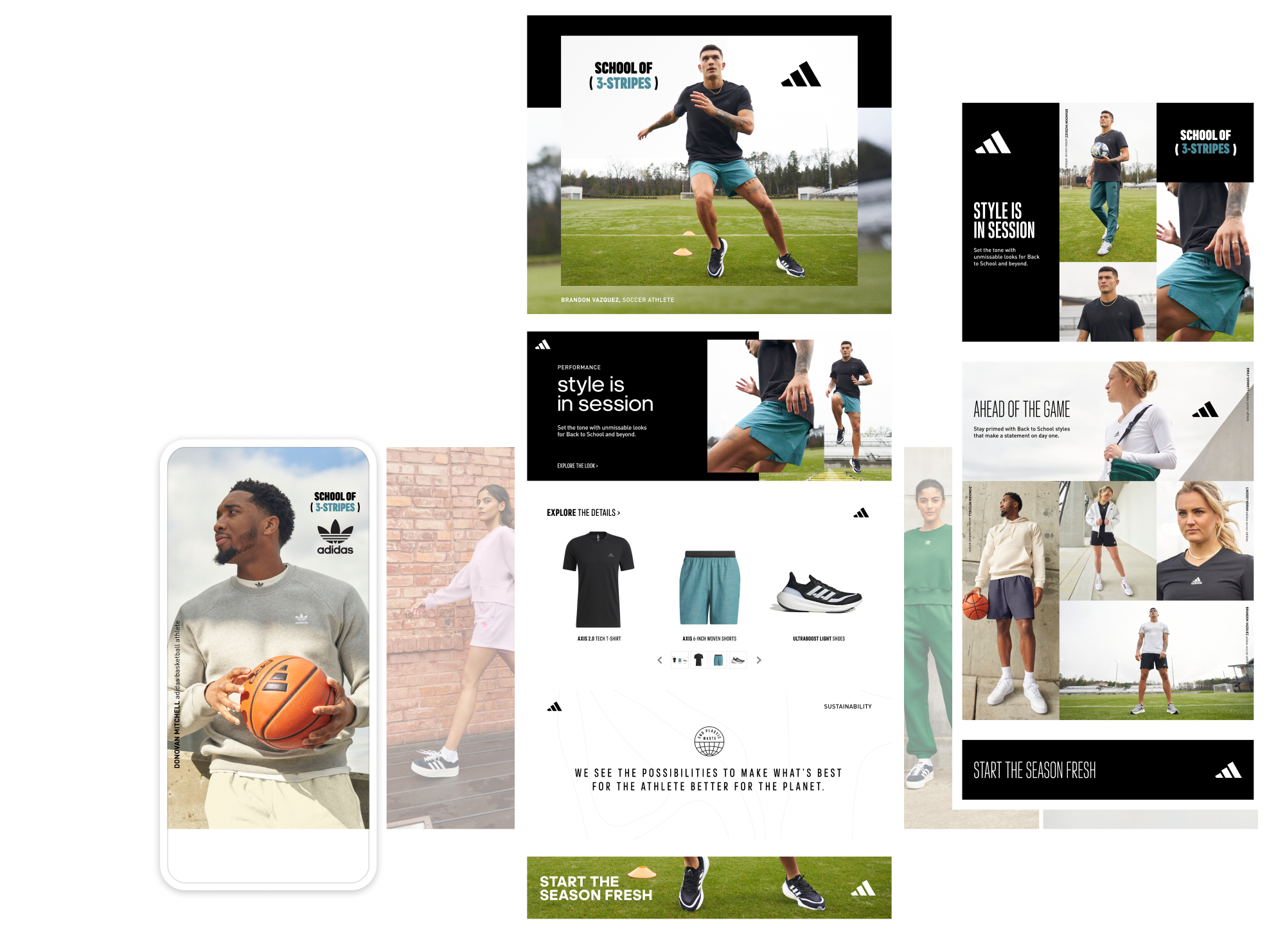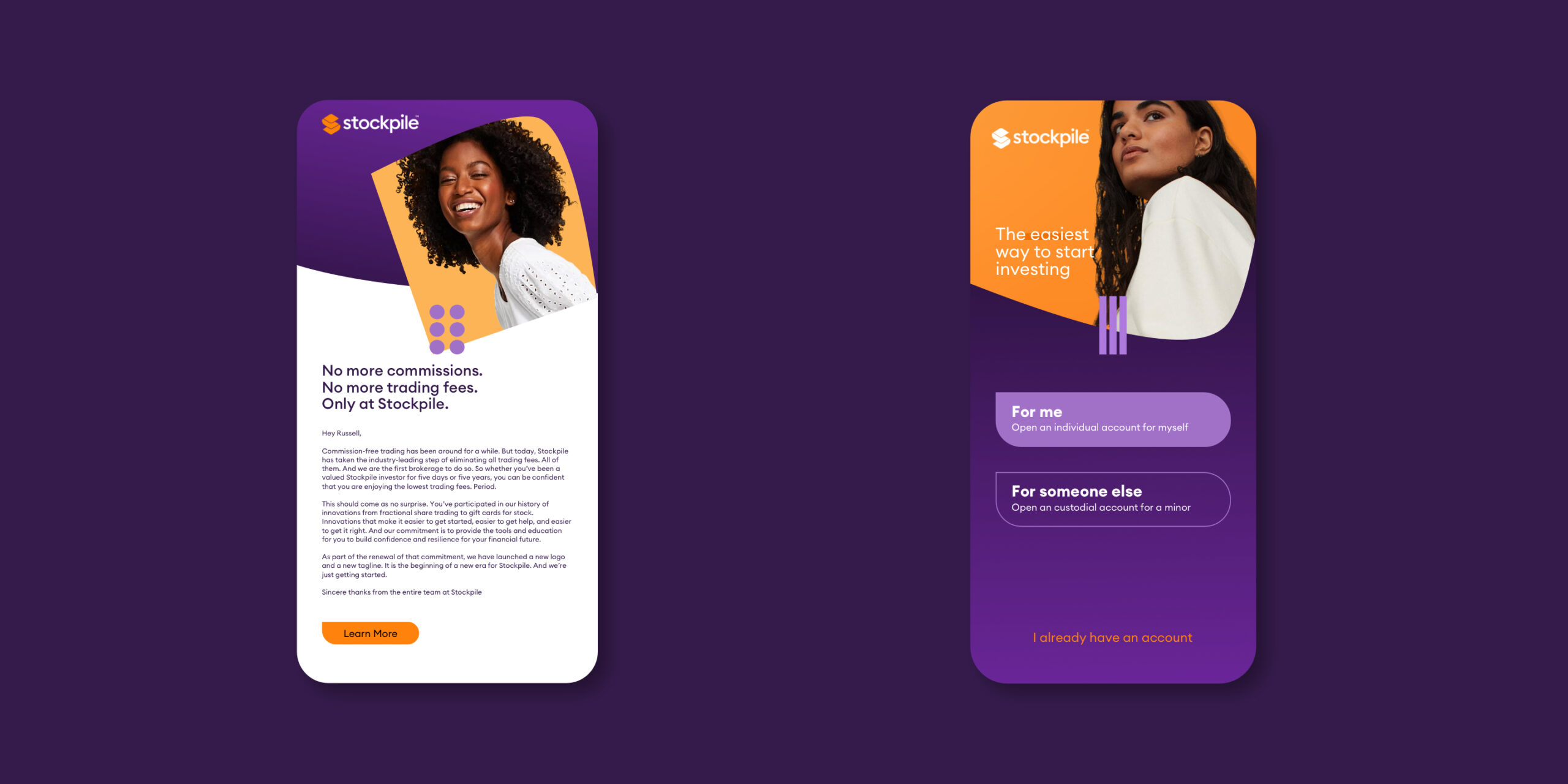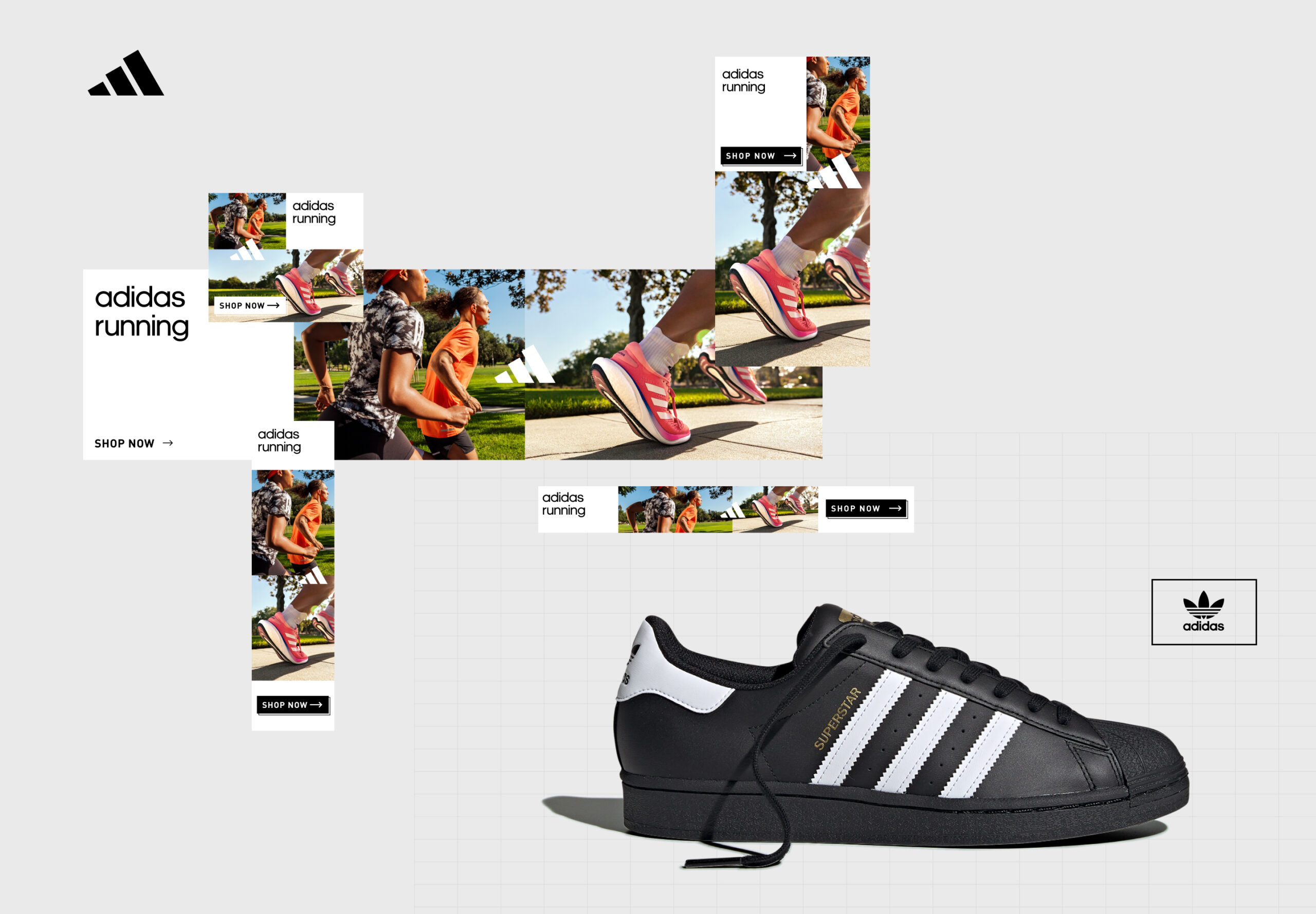In the dynamic digital landscape, establishing your brand’s identity across multiple online touchpoints is paramount.

What is Digital Branding
With consumers spending as many as 7 hours a day online, a robust digital branding strategy presents an unmatched opportunity for nurturing awareness, engagement, and sales.
For over ten years, we’ve worked with industry innovators like Salesforce, Levi’s, and Slack, helping them develop and showcase best practices. Brands like these convey consistent messaging and reinforce their core values across a variety of digital media.
Following similar playbooks, digital-first brands build expansive online footprints through compelling social content, helpful resources, and a host of free and paid-for tools.
An optimized digital branding approach can strengthen recognition and loyalty by delivering value both through your owned content platforms and through each individual customer interaction. With expanded reach, accelerated conversion rates, enhanced affinity, and lower acquisition costs, mastering the digital world has become essential for business success.
Why is Digital Branding Important?
In the fast-paced world of digital innovation, prioritizing digital branding is the key to securing a lasting competitive advantage for your brand. It opens doors to broader reach, yields higher conversion rates, strengthens brand loyalty, and affords more cost-effective customer acquisition.
What Are the Benefits of Digital Branding?
Advantages include expanded reach through targeted campaigns, increased conversions from customer-centric experiences, heightened brand affinity via interactive content, improved ROI, and data-driven insights for smarter decisions.
The world has rapidly shifted online. And online use will only grow over time. Brands that adapt to the modern marketplace will thrive in the 21st Century. Those who do not look set to struggle.

Develop a Digital Branding Strategy
Set Clear Goals
Set clear goals for brand visibility, audience engagement, and sales conversions to guide your digital branding strategy.
Conduct an Audit
Conduct a comprehensive audit of existing digital assets, including your website, social media pages, and campaign metrics, to identify strengths and areas for improvement.
Look at the Data
Utilize customer data from analytics and CRM tools to gain insights into key audience demographics, interests, and media habits.
Messaging is Key
Craft core brand messaging that highlights your competitive differentiation and specific value proposition, customized to address customer desires and pain points.
Stay Consistent
Establish style guidelines governing logo usage, color palette, typography, imagery, and tone-of-voice to ensure a consistent brand identity across all digital touchpoints.
Create Content
Develop valuable, entertaining, and educational content in various formats that align with audience preferences and key stages in the customer journey.
Promote Contnet
Promote your cohesive content consistently across owned, earned, and paid media channels to maximize exposure.
Test and Measure
Monitor key performance indicators (KPIs) for your digital branding efforts and correlate them with sales data to demonstrate ROI. Use these insights to refine your strategies for ongoing success.
Keys to Successful Digital Brand Strategy
A winning digital brand strategy hinges on a deep understanding of your audience’s needs and behaviors. Top-tier digital brands are downright fanatical about their customers, with data-driven insights as the driving force behind their strategies.
To maintain strong digital brand recognition, it’s imperative to maintain a consistent personality and messaging across all your branded touchpoints – while staying relevant in each unique digital channel. In simpler terms, you must remain loyal to your brand while accommodating the unique demands of each digital destination.
Innovative tactics, like immersive augmented reality experiences, can generate buzz while still staying true to your brand’s core attributes. Additionally, simplifying digital interactions by delivering valuable utility goes a long way in removing friction and elevating the digital brand experience. Given that mobile devices rule the digital realm, adopting a mobile-first approach to branding is not just a choice; it’s a necessity.
Checklist for Auditing Your Digital Branding
Taking a systematic approach to auditing your digital brand is an absolute game-changer for sustained success in today’s digital-first world. Given the ever-shifting landscape, conducting regular digital branding check-ups helps you identify areas that need a rethink and helps to keep your brand relevant.
By regularly evaluating the criteria below, you ensure that your digital branding remains on the cutting edge and poised for long-term success. The marketing landscape has never been this dynamic. And taking a constant pulse is your only way of keeping ahead of the curve.
In this comprehensive assessment, several key aspects should be on your radar. These include but are not limited to:
Website traffic volume and sources
Conversion rates for desired on-site actions
Search engine visibility and keyword rankings
Social media reach and engagement
The performance of active digital campaigns
Brand sentiment analysis
Customer feedback and online reviews
Testing the resonance of your branded content assets
Metrics tracking for email campaign engagement

Build Brand Identity and Presence
Develop a Brand Messaging Strategy
A captivating brand messaging strategy serves as the bedrock for crafting an unforgettable digital brand that strikes a chord with your target audience. To effectively cater to customer needs and gain a competitive edge, many brands establish what they call digital “brand pillars.”
These pillars should directly connect with your customers’ desires and challenges, showcasing your company’s relevance. To breathe life into each pillar’s messaging strategy, top-notch copywriting skills are a must. They enhance the memorability and effectiveness of your digital brand messages.
Consistency is the linchpin, so ensure this messaging resonates across all digital brand touchpoints. Tailor each piece of communication to its specific audience, considering the nuances of the communication channel for maximum impact. In other words, what might work for a brand on LinkedIn would be very different from the same content shared via Instagram. Think of this as the digital equivalent of “reading the room.”
Implement a Content Marketing Strategy
Content marketing is the rocket fuel of a robust digital brand. It generates interest and sparks engagement across the disparate digital universe. Craft informative blogs, videos, and infographics tailored to your audience’s interests. Fine-tune your content to rank well in relevant searches, bolstering your visibility on search engines. Then, strategically disseminate this content across your owned websites, social media profiles, and email campaigns to broaden your outreach.
By seamlessly weaving together a variety of media – from text, graphics, motion graphics, and testimonials – you can supercharge visibility and engagement. But to bolster effectiveness, ensure that crystal-clear calls-to-action are in place to seamlessly guide users through their journeys.
And, don’t forget to keep a watchful eye on content performance. This allows you to continuously refine what you say and where you say it. An audience-centric approach is the key to producing value-packed content at scale, taking your content marketing strategy to the next level.

Define Your Brand Identity
Your digital branding is the visual cornerstone of your online brand identity. It encompasses various elements that make your brand easily recognizable wherever it shows up online.
Logos serve as your brand’s instantly recognizable north star, playing a pivotal role in anchoring your online presence. Your choice of corporate colors reflects your brand’s personality, constituting a vital component of your online branding toolkit. The typography you use contributes to your brand’s tone and influences how you are perceived in the online arena.
Your overall aesthetic goes a step further, reinforcing your brand’s values and ensuring your online audience resonates with your unique perspective. In the best-case scenario, a well-rendered visual brand not only represents but also strengthens your brand’s mission statement.
By seamlessly integrating all of these elements into your branding, the goal is to forge an emotional connection between your digital brand and your customers, elevating your brand recognition and resonance in the process.
Design a Memorable Logo
A memorable logo is a powerful tool in the digital world, quickly and almost imperceptibly communicating your brand’s promises and values. The process of condensing your brand essence into a memorable wordmark or icon is nothing short of a form of modern alchemy.
Logos need to work hard to stand out. They must be unique and instantly recognizable and convey your brand’s identity effectively. Simplicity, versatility, and strategic color use are key. Clever visual elements, like the hidden arrow in the FedEx logo, can enhance memorability.
Clear guidelines maintain consistency as your logo scales across digital platforms, ensuring its impact and effectiveness.
Create Digital Brand Guidelines
Creating accessible brand guidelines is crucial for maintaining a consistent and impactful online brand presence. These comprehensive guidelines serve as your brand’s north star, encompassing the macro and micro take on your brand. Typically they feature logo specifications, color choices, font selections, and a myriad of graphic elements. They play a pivotal role in ensuring your brand’s faithful representation across various digital platforms.
These guidelines serve to expand beyond the basic visual system; they also encompass your brand’s primary, secondary and tertiary colors, key font choices, and type formatting guidance tailored specifically for each digital use case.
By providing insights into ideal layout principles and strategic image placements through visualized grid systems, these comprehensive brand guidelines empower your team to deliver a seamless and cohesive brand experience. This playbook transcends individual platforms, enabling consistency across websites, within digital communities, through email communications, or through diverse advertising channels.
Additionally, these guidelines offer explicit instructions on conveying the appropriate brand voice. Building consistency like this fosters customer loyalty and resonance throughout your presence on social media channels as well as a variety of digital touchpoints, reinforcing your brand’s identity and impact in the process.
Build and Optimize Your Website
Your brand website serves as the central hub for your digital branding efforts, and remains a critical asset in your online business strategy. When designing your primary site, ensure a prominent display of your logo, tagline, and colors – all in alignment with your brand style guidelines, delivering a consistent experience online.
To establish a strong online presence and connect with your target audience, showcase credible social proof through testimonials and notable press mentions. Don’t underestimate the power of social proof to build immediate credibility.
Guide users through tailored conversion funnels by optimizing information architecture and user flows. Rigorously test and optimize these pathways to ensure your brand strengthens over time.
A good-looking site is nothing without performance to match. Maintain optimal website performance with fast load times and streamlined checkout processes, reducing friction for your audience at every turn.
In the always-on era, responsive designs that adapt to a plethora of devices are essential. Continuously optimizing your site can minimize bounce rates, supercharge lead generation, and solidify your brand’s online presence. In digital, it’s best to leave nothing to chance.
The Importance of Search Engine Optimization
In the ever-evolving digital landscape, digital branding enables the implementation of crucial strategies like search engine optimization (SEO).
SEO plays a pivotal role in expanding organic visibility, ensuring that your brand reaches specific customer groups effectively. By optimizing web pages for search terms that are aligned with your digital brand’s products and services, you can attract a loyal customer base through improved search engine rankings. It’s often been said that in business, the key to success lies in visibility first, availability second, and ability third.
Additionally, prioritizing page speed enhancements contributes to the success of search engine ads and Google Ads, making your company more accessible and visible through an online search. Embracing mobile optimization is essential to offer seamless digital brand experiences, especially in the age of social media advertising and online reviews. Furthermore, the creation of share-worthy content that earns reputable links further enhances your digital brand’s authority and impact.
In the long run, these digital branding efforts, coupled with effective SEO, form the backbone of your digital presence. They help you capture and hold onto audiences across various online platforms, ensuring your brand remains a force in an increasingly competitive marketplace.

Execute Digital Branding Tactics
Create Social Media Campaigns
In digital branding, well-executed social media campaigns have a prominent role to play, driving effective digital marketing strategies and enhancing your overall brand strategy. These campaigns can become marketing powerhouses that boost awareness and engage your target audience across the channels they frequent the most.
By tapping into the power of social media, savvy marketers create catchy hashtags to kickstart discussions and naturally encourage the sharing of user-generated content. Running contests with enticing prizes and making channel-specific special offers encourages sharing and tagging, igniting audience enthusiasm and further aligning with your other content marketing initiatives.
Timing is crucial in the digital branding business. Social feeds come to life around key holidays. Timely seasonal campaigns capitalize on existing consumer sentiment. Influencer partnerships amplify credibility through co-created endorsements, adding authenticity to your social media marketing. Sharing behind-the-scenes content provides an insider’s view of your company culture, deepening the bond with your audience.
By diligently tracking impressions, reach, and engagement, you can measure the impact of your social media and digital branding efforts. Well-crafted campaigns foster personal connections with your brand, consistently producing shareable content that invites active participation in your digital branding journey.
Leverage Social Media Platforms
In today’s digital landscape, social media platforms like Facebook, Instagram, Twitter, YouTube, and LinkedIn have essentially become the modern-day equivalent of town squares.
They’ve taken up the mantle as crucial channels for brand building. These bustling online spaces provide a public forum for open dialogue, story-sharing, and connectivity.
They also serve as unique arenas for brands to shine a spotlight on their community activities, share everyday moments, engage in meaningful conversations, and showcase their leadership perspectives.
The key to success here? Tailoring your content to match each platform’s unique use cases. By doing so, brands can supercharge engagement, cultivate vibrant communities, foster diverse discussions, and fortify their digital footprint. This sets the stage for multi-faceted engagement across these sprawling networks, making the most of what they have to offer.
Track and Measure Your Results
In the digital realm, branding comes to life through thoughtful content marketing and savvy digital campaigns. The digital advantage lies in tracking their impact, allowing near-constant assessment of ROI and, subsequently, strategy refinement.
Your marketing team should dive deep into the data, measuring campaign awareness and effectiveness. Web, campaign, and platform analytics provide insights into multi-channel performance, ensuring your online branding resonates with your audience.
Tracking digital branding effectively also includes “social listening” – the process of monitoring and analyzing conversations and trends happening on social media to understand what customers and potential customers are saying about a brand, industry, or specific topics. It’s not just about collecting data on mentions, likes, or shares but also about gaining insights into the mood, opinions, and needs of the audience.
Marketers also need to pay attention to ad platform analytics, CRM analytics, and email engagement metrics to gauge the strength of each campaign.
In the data-rich digital world, a data-driven approach should be used to justify ROI and secure budgetary support for future campaigns.
Email Marketing
Email marketing, despite its veteran status, remains a potent tool for connecting with your target audience. Recent personalization strategies like “lead magnets,” offering free branded resources in exchange for new customer signups, have revitalized its effectiveness.
Behavioral targeting enhances engagement by aligning content recommendations with on-site activities, boosting open and click-through rates. Personalized subject lines, driven by segmentation and geotargeting, increase open rates. Re-engagement campaigns revive inactive subscribers with tailored promotions based on past but lapsed interactions.
Given the mobile-dominated email landscape, responsive design is crucial for frictionless small-screen experiences. Branded email newsletters, as private digital communication gains traction, provide a valuable means for consistent, large-scale brand dialogues, setting your campaigns apart and highlighting your unique selling proposition.
Build an Email List
Broadening your base of direct customer email contacts serves as the lifeblood of sustaining ongoing brand conversations and fuels the engine of relationship marketing with your target audience.
Some typical strategies encompass deploying website signup forms that entice with exclusive gated content in return for subscriptions, harnessing attendee information from social channel event pages, employing in-app integrations that prompt email signups, incorporating printed QR codes on packaging that guide consumers towards opt-ins, and forging retail partnerships to enroll in-store shoppers.
Email emerges as the conduit for consistently delivering scalable, measurable, and long-term brand communications. Crucially, the foundation of its success hinges on cultivating a clean, up-to-date, and pertinent email list. Make this an absolute priority to capitalize on all the work you have put into your digital brand.
Invest in Paid Advertising
Allocating a segment of your digital branding budget towards paid advertising across various online channels can significantly elevate your brand’s visibility, delivering substantial returns on your overall brand investment.
Paid advertisements empower your brand to cast a wider net, reaching a broader target audience while simultaneously cementing essential brand recognition.
In today’s marketing landscape, the array of choices can be overwhelming. Rich media and video advertisements excel at conveying compelling narratives and forging deeper connections with your audience. The implementation of multi-touch attribution methods provides a means to quantify website visits and trace sales stemming from exposure to your brand. Continuous experimentation with various combinations allows you to tap into incremental audiences, ultimately driving tangible results.
Distinguishing itself from traditional marketing, digital advertising’s adaptability extends across a spectrum of new and emerging channels, encompassing search engines, mobile apps, social media, and email marketing, effectively maximizing your brand’s online footprint.
Search Engine Advertising
Prominently display highly targeted ads alongside pertinent search engine results, proactively reaching audiences the moment queries indicate a user’s intent.
Display Advertising
Strategically place eye-catching banner, image, and text promotions on frequently visited websites, efficiently increasing brand visibility to pertinent demographics.
Social Media Advertising
Expertly leverage platforms like Facebook and Instagram to deliver ads precisely tailored to users’ interests and behaviors based on far-reaching digital footprints.
Native Advertising
Skillfully design advertisements that seamlessly match the look and feel of surrounding media formats, integrating them fluidly into content streams.
Video Advertising
Creatively showcase clips before, during, or after relevant streaming content on sites like YouTube, leveraging the intrinsically engaging video storytelling format.
Affiliate Marketing
Judiciously partner with relevant websites and influencers to promote products or services on a performance basis.
Influencer Marketing
Collaborate with popular social media personas to highlight offerings to their expansive, engaged follower bases.
Mobile Advertising
Display promotions in mobile applications, mobile websites, or targeted text messages to reach on-the-go users.
Retargeting
Serve contextually relevant ads to previous website visitors to incentivize returns and actively encourage conversions.
Programmatic Advertising
Seamlessly leverage automated technologies enabling real-time buying and selling of digital advertising space.
Content Marketing
Proactively create and widely distribute valuable, relevant content that attracts and actively engages clearly defined target audiences.
Pay-Per-Click (PPC) Advertising
Prominently place text, image, or video promotions on search engines and social platforms, paying only when users click them.
Sponsored Content
Strategically pay publishers to feature articles, videos, posts, or other branded content on their far-reaching distribution channels.
Interstitial Ads
Display full-page promotional messages before expected webpage content loads, typically with countdowns or close buttons.
Engage with Your Audience
Creating a stunning, resonant brand is only half the battle. Without meaningful engagement with consumers, a cohesive brand experience can fail to live up to its promise. Central to the digital brand experience is the fostering of a genuine, two-way dialogue between brands and their target audiences. Without active participation from customers, a brand remains an unrealized vision.
Facilitating meaningful dialogue delivers multiple benefits and should play an important part in your digital brand strategy. By taking an active role on your own social media channels, you have the opportunity to create positive, organic interactions with customers.
You can also broaden your brand’s reach by encouraging user-generated visual content that resonates with the trends of the day in the digital landscape.
You can also augment this approach through the collection of feedback from online focus groups, enabling brands to adapt rapidly to emerging consumer sentiment.
These days, real-time dialogue has been made feasible through messaging and AI chatbots, each establishing a rapid connection between you and your coveted audiences.
This strategic approach positions brands as receptive partners, nurturing trust and reaping significant consumer rewards, ultimately fueling robust growth in the digital arena.
User Experience is Your Brand Experience
For many businesses and services, the brand exists almost entirely online. Therefore, delivering a seamless user experience, no matter where users find you, is paramount.
Making a commitment to user experience design not only enhances your online brand but also serves to attract and retain customers.
To excel in digital brand marketing, make sure you address user pain points by refining information design, offering clear microcopy guidance, and anticipating user needs proactively.
Prioritize mobile page speed and a frictionless account sign-up process. Incorporate surprise-and-delight elements like gamification for increased engagement. Actively seek consumer input and close the feedback loop to foster loyalty and strengthen your brand story.
Taking a user-centric approach should form the cornerstone of your digital strategy, solidifying your online presence and leaving a lasting positive impression on your audience.
Successful Digital Branding
This was an exhaustive article. And yet it really only touched briefly on each topic. The bottom line is that digital brand marketing is a complex but inherently rewarding world. With the sheer variety of platforms and channels to market within, and given the array of analytics tools at our disposal, we now have the tools we need to craft resonant brands that thrive in this always-on, always-evolving world.
Let’s Talk
Thousands of brands, both large and small, have woken up to the potential of Amazon to drive unparalleled growth in their businesses. Whether you’re new to the platform or looking to take your Amazon game to the next level, we’re confident we can help.
Drop us a line.
Contact us120 2nd St. Floor 3,
San Francisco, CA 94105



